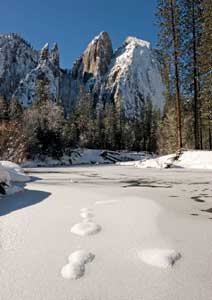In the spring and early summer, the iconic waterfalls of
Yosemite National Park — Yosemite, Bridalveil, Vernal, Nev. —
draw thousands of visitors every year to marvel at their
grandeur
New snowmelt, pulled by gravity and pinched between granite creek banks, races on, gathering momentum. Then, in an instant, the water leaps over the edge of a huge granite precipice into a dizzying void; a void carved out long ago by a river of snowflakes over thousands of years.
In the spring and early summer, the iconic waterfalls of Yosemite National Park — Yosemite, Bridalveil, Vernal, Nev. — draw thousands of visitors every year to marvel at their grandeur. But for those of us who also look for solitude in a natural setting, visitors to Yosemite Valley pay a price: People, lots of people. If you are lucky enough to have a reservation, you’re still faced with searching for a parking spot or waiting for a meal. The paved trail from Happy Isle up the Merced River to Vernal Falls can resemble Valley Fair shopping mall at Christmas.
Two of the nicest visits I have made to Yosemite Valley have been in winter. Many years ago, Renee and I spent a couple of January nights in Curry Village. The previous summer, we had stayed there with our then-young children. Invariably, it took several trips up and down a huge parking lot to find a space. On our January visit, we parked right in front of our cabin, one of only five cars in the massive lot. I took a morning run up the trail to Vernal Falls and saw no one. We enjoyed not just the beauty there, but also the restorative peace of wandering quietly through the valley in winter.
I enjoy photography and have meant for years to go to Yosemite Valley immediately after a winter storm. (Our earlier visit had been during a mild winter and very little snow was on the ground.)
So, last winter, immediately after a big Sierra storm, I threw my camera gear into the car and headed out well before sunrise. As is often the case when one prowls around during odd hours, I was treated to an unexpected attraction. Halfway across the Central Valley, the sky still black, a narrow crescent moon rose bright in the southeast, beautifully accented by a brilliant Venus. Pushing on, I knew I wouldn’t arrive in the valley by sunrise, the best time for photography, but I also knew that the valley floor would remain in shade until the sun rose above the walls that envelope it.
When I arrived, I could see that everything was perfect. Every feature in the valley was draped with an elegant fresh coating of snow, yet the sky was blue and the day was bright. I scouted valley locations along the river, hoping for an interesting view across untrammeled snow. Getting to secluded spots near the river meant slogging through thigh-high drifts. But once there, I saw Yosemite Valley in a way I never had before — as if I were an ancient resident here. The sense of remoteness was nearly complete. The sound I most often heard was ice tinkling down the granite faces, released from its perches by the warmth of the morning sun. It turned me from my camera, and I looked up toward El Capitan, listening and watching for snow and ice sloughing off the face. That’s how quiet it was. I had never heard such silence nor enjoyed such solitude in Yosemite Valley.
I went up and came back in a day, and it wasn’t hard. I was through shooting photos by mid-afternoon and home by dinner. Yosemite Valley is beautiful any day, but it is magical in winter, when even a weak imagination can conjure the idea that you are there alone.
Watch the weather reports. Call in sick.








